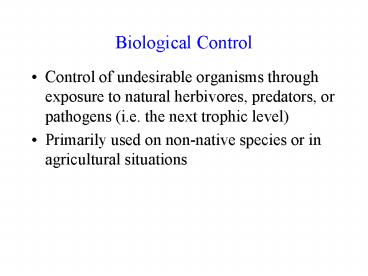Biological Control - PowerPoint PPT Presentation
1 / 29
Title:
Biological Control
Description:
Via reduction in density, seed production, and potential ... foliage removed. Beetle attack. plant biomass. Data from Denoth and Myers 2004. Purple loosestrife ... – PowerPoint PPT presentation
Number of Views:70
Avg rating:3.0/5.0
Title: Biological Control
1
Biological Control
- Control of undesirable organisms through exposure
to natural herbivores, predators, or pathogens
(i.e. the next trophic level) - Primarily used on non-native species or in
agricultural situations
2
Biological Control
- Goal reduction of population sizes, not
elimination - Via reduction in density, seed production, and
potential for spread - Expensive to establish, but then needs little
maintenance, may have lower negative effects than
chemical control agents
3
The Equilibrium Paradigm
4
How it works
- Is the invasive an ecological or economic
problem? - Is there sufficient support to initiate a
biocontrol program? - If yes.
5
How it works
- Locate candidate agents in native habitat
- Check for specificity of attack
- Lots of regulation, long approval process prior
to release
6
The situation in BC
- Crop losses due to weeds and control costs
estimated at 50 million annually - Weed control act duty of land occupier to
control legislated noxious weeds - BC uses 57 bioagents against 20 weed species
7
St. Johns Wort, Hypericum perfoliatum
- Weed of rangelands
- Causes phototoxic response in grazing mammals
- Originally used chemical control, but
- St. Johns Wort was first plant to return
- Problems with leaching into other areas, lack of
specificity of chemical agents
8
St. Johns Wort
- Two defoliators, Chrysolina quadrigemina and C.
hyperici, introduced in 1951 - No longer have economic effects, no longer spray
herbicides - Beetles do attack introduced ornamental Hypericum
9
Tansy ragwort, Senecio jacobaea
- Alkaloids cause liver damage in grazing mammals
10
Tansy Ragwort
- feeding by Longitarsus jacobae (Switzerland)
- invasive gt native
Stastny, Schaffner, Elle 2005
11
Tansy ragwort
- Longitarsus not very effective in BC
- Working well in Oregon (below)
12
Tansy ragwort
- Cinnabar moth, Tryia jacobaeae, also introduced
in BC - Combined agents showing some success near Nanaimo
- S. jacobaea continues to spread esp. after fires
and along power lines
13
Purple loosestrife
- Lythrum salicaria
- Alters hydrology, nutrient cycling
- Outcompetes native vegetation
- Reduces breeding sites of wetland birds
14
Purple loosestrife
- Galerucella calmariensis and G. pusilla
introduced for control (in BC, intro in 1992) - Effective defoliators
- Plants are killed by heavy beetle attack.
- Has worked at many sites in B.C. and across
northern North America - Loosestrife often replaced by reed canary grass
another invasive!
15
Purple loosestrife
foliage removed Beetle attack
plant biomass
Data from Denoth and Myers 2004
16
Gorse (Ulex europaeus)
- In parts of North America, gt90 seed predation,
but no effect on invasiveness of weed - Why are seed predators often chosen for
biocontrol, and why might they be ineffective at
control?
17
Diffuse Knapweed
Cost 1 million/year in lost forage 1940 -
Penticton, Oyama, and Grand Forks
1970 - Thompson and Okanagan Valleys
1972 began biocontrol
18
Larinus sp. Metzneria paucipunctella (larvae feed
on seeds)
12 different insects and a fungus have been
introduced for control!
(from Judy Meyers)
19
Data Judy Myers
20
When good bugs go bad
- Louda et al 1997. Science 2771088-1090
- Weevils (Rhynocillus conicus) released in Canada
to control invasive thistles (Carduus spp.) in
1968 - Subsequently released in US, now well established
throughout North America
21
When good bugs go bad
- Releases done even though weevils were found to
use native thistles Cirsium, Silybum, and
Onopordum (with oviposition preference for
Carduus) - Some native thistles are considered rare and are
negatively impacted in US
22
Evil Weevils?
- Increase in use of native plants by weevil
biocontrol agent in US parkland
Abbreviations indicate native species and
location in parks
23
Evil Weevils?
- A simple equilibrium that allows persistence of
both a predator and a prey species not expected
when the predator has multiple prey species - Important to do both careful pre-release
screening and follow-up work
24
Biocontrol of plant pests
- Ladybugs, lacewings, parasitic wasps used in
greenhouses and gardens for control of herbivores - Large industry for rearing, dispersing
biocontrol agents
25
Conservation Biocontrol
- Manipulate environment to increase natural
enemies, avoid using chemicals, especially in
agroecosystems - Habitat management may increase biodiversity
26
Conservation Biocontrol
- Improve availability of alternative foods
nectar, pollen, honeydew - Provide shelter or benign microhabitat for
overwintering or escape pesticides - Provide habitat where alternate prey are present
- Provide temporal and spatial overlap in resources
27
Conservation Biocontrol
Canola / Wheat adjacency syrphids in wheat had
canola pollen in guts aphid populations in wheat
tended to be lower
Rhodesgrass (Chloris gayana) in citrus orchards,
pollen is food source for predatory aphids of
herbivorous mites
28
Effectiveness of biocontrol can depend on
landscape factors Border types affect Syrphid
movement
Phacelia
Traps
Wratten et al 2003 Oecologia 134 605-611
29
Conservation biocontrol
- Some changes to traditional farming practices can
reduce pest populations through consideration of
ecology of their enemies - Need enough benefit to justify taking land out of
production or making other changes































